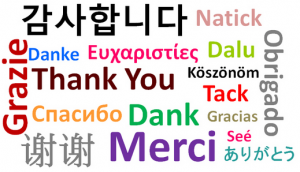What is the most difficult language to learn? It seems like everybody has their own answer to this question. Recently, however, the Foreign Service Institute of the US Department of State compiled learning expectations for native English speakers looking to achieve proficiency in various foreign languages. They based it upon factors such as the language’s complexity, the resources available, how many hours would be devoted to study each week and the students’ motivation. I recently came across an infographic that broke down various languages into easy, medium and hard language categories.
The “easiest” languages, such as Dutch, Swedish, Afrikaans, Norwegian and the Romance Languages, require just 23-24 weeks of study, or 575-600 class hours, to achieve proficiency. This is due to the languages’ closeness to English; Dutch, Swedish, Afrikaans and Norwegian are all Germanic languages, like English, while English heavily borrows from Romance Languages. German, also a Germanic language, falls somewhere between “easy” and “medium”.
“Medium” languages require 1,110 class hours or 44 weeks to achieve proficiency. These languages include Hindi, Russian, Vietnamese, Turkish, Thai, Polish, Finnish, Hebrew, Greek and Serbian. Half of these languages (Vietnamese, Turkish, Thai, Hebrew and Finnish) aren’t even part of the Indo-European language family. And those that are come from branches of the Indo-European language family far removed from English; Hindi is Indo-Aryan, Greek is Hellenic and Polish, Serbian and Russian are all Slavic.
 The most difficult language for English speakers require, on average, 88 weeks or 2,200 class hours to reach speaking and reading proficiency. These include Korean, Japanese, Chinese and Arabic. Each one of these is difficult for their own reason. Chinese and Japanese learners need to memorize thousands of characters. Chinese is a tonal language, with meanings that change as you change the tone of a word. Korean has a vastly different sentence structure, syntax and verb conjugations than English, making it difficult for English-speakers. And Arabic uses much fewer vowels than English, making it difficult for those learning the language to both pronounce and read.
The most difficult language for English speakers require, on average, 88 weeks or 2,200 class hours to reach speaking and reading proficiency. These include Korean, Japanese, Chinese and Arabic. Each one of these is difficult for their own reason. Chinese and Japanese learners need to memorize thousands of characters. Chinese is a tonal language, with meanings that change as you change the tone of a word. Korean has a vastly different sentence structure, syntax and verb conjugations than English, making it difficult for English-speakers. And Arabic uses much fewer vowels than English, making it difficult for those learning the language to both pronounce and read.
This was an interesting list to read, and without a doubt I’m not denying how difficult these various languages are to learn. However, the list neglected to mention a lot of the more “obscure” languages. There’s a known tendency in languages with small communities to show far more complicated structures than the ones that are widely spoken, probably because the language evolution is slowed down, since children must grow up with adults that have a full language. Language isolates such as Basque, Georgian, Khoisan, Dyirbal or Inuktitut are known to be extremely difficult for their complex grammar and/or pronunciation rules. I wonder where such languages would show up in the list.